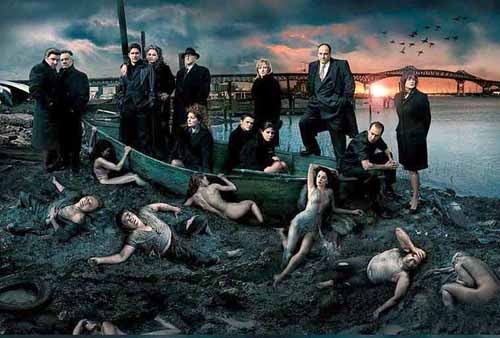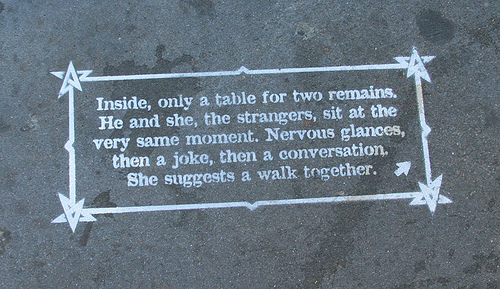
This past April, as the final season of The Sopranos hit the airwaves, with seemingly the whole country bracing for impact, I’d still never seen a single episode. Gradually, my indifference turned to concern. It felt like every talk show, news culture section and conversation on the street was about the fate of Tony Soprano -? a latter-day American anti-hero, a titanic figure with the air of myth about him. I began worry that I’d missed out on something big. A cultural touchstone of rare proportions.
So, as the end drew near, I took a deep breath and decided to start from the beginning.
Six months, 86 episodes, and over 70 combined viewing hours later I’m finally done, and while I may have missed out on The Sopranos as a broadcast event -? seven seasons of weekly appointments with Tony, Carmela, Meadow, AJ and the whole crumbling world of New Jersey gangsterdom -? I got to experience something perhaps more satisfying: a hyper-concentrated, solitary viewing experience, curled up nightly in bed with my laptop. Episodes flowing into each other almost seamlessly like chapters of a book. The pause button like a dog-eared page or bookmark inserted as my eyelids began to droop. An experience not unlike reading a big novel.
Book lovers frequently insist they could never get in bed with a computer, but it seems that this is happening all the time. Any of you who have indulged in a multi-season TV binge can probably attest to this -? hours spent prone, the laptop huffing away, plowing through disc after disc (Bob made a similar observation a while back). Substantively too there’s something that recalls leisure reading. It has oft been remarked that The Sopranos heralded a major shift in television into terrain once solely occupied by the novel: serial dramas that transcend their episodic structure and become a new kind of literature. Big cross-seasonal plot arcs. A broad social canvas. Intricately interwoven narrative. A large cast of deeply drawn characters. Not to mention a purchase on the country’s imagination that recalls the popularity of the great serial fictions of Dickens a century and a half ago. With the spate of high-caliber TV serials originated by HBO and then proliferated by channels across the television spectrum, film has moved onto the novel’s turf, matching not only its narrative scope but its expansive dimensions. Stories as big and sprawling as novels can now be told in moving pictures, and thanks to a host of new individualized distribution channels, experienced as intimately, on a laptop or iPod.
Of course I’m not suggesting that film and prose fiction aren’t very different things, just that their roles seem to be converging. From its early days, film has been in conversation with the novel, frequently operating on canvases as vast as Anna Karenina or Great Expectations, but it necessarily has had to compress, select and distill the worlds it shows into something in the vicinity of two hours. When a film edges toward the three-hour mark it is considered epic. Simply in terms of duration of story and investment of time by the viewer/reader, movies and novels have always been very different kinds of fiction requiring very different sets of commitments from their audiences.
The shift arguably began with the multi-episode adaptations of classic books pioneered by the BBC in the 70s -? shows like I, Claudius, on through the 1995 hit rendition of Pride and Prejudice, right up to last year’s Bleak House. Here, television began to stretch out novelistically. And indeed, novels were the source material. Still, the solitary “reading” element was absent here. These were broadcast events, viewed in living rooms at an appointed time set by the channel, with little or no control by the spectator. Soon enough, however, VCRs entered the home and television audiences became time shifters, capturing and bending the broadcasters’ schedules to fit their own. From there the die was pretty much cast. A parade of new “narrowcast” technologies -? DVDs, TiVo, personal computers, iTunes, bit torrent -? imbued these shows with book-like qualities: reader-driven, personal, portable… an intimate cinema of one.
Immediately upon finishing The Sopranos, with the pangs of withdrawal already setting in, I found solace in Wikipedia, which has extensive articles on each episode and character from the show. With the help of the external links, I soon found myself on a strange digital dérive through various arcana: press clippings, blogs, and an forums debating the show’s ambiguous ending, personal web pages of supporting cast members such as Joseph R. Gannascoli, who played the gay mobster Vito Spatafore, and from whose site one can purchase such fine collectibles as t-shirts emblazoned with “I Love You Johnny Cakes.” Through the drifts of trivia, I eventually dug up several interesting quotes from contemporary authors ruminating on the novel’s place in American life and the increasing overlap with television. The first bits were from John Freeman, president of the National Book Critics Circle, who published a piece in The Guardian during those fevered months surrounding the Sopranos finale entitled “Has the novel been murdered by the mob?”
From coast to coast, from white-wine sipping yuppies to real life mobsters, The Sopranos has had Americans talking – even those of us not familiar with the difficulty of illegal interstate trucking or how to bury a body in packed snow. While the New York Times called upon Michael Chabon, Elmore Leonard and Michael Connelly to resurrect the serial novel in its Sunday Magazine, critics were calling Chase the Dickens of our time. The final episode roped in some 11.9 million viewers. One major question, though, remains. Has Tony Soprano whacked the American novel?
….America’s most powerful myth-making muse long ago moved in to Hollywood (and the White House press room), so the ascendancy of The Sopranos to the level of quasi-literary art should have been expected. Indeed, this wouldn’t be troubling were Americans reading other, actual novels. But they’re not – at least not in the numbers they once did.
Freeman cites two authors, Gary Shteyngart and the late Norman Mailer, both of whom have discussed The Sopranos as a story of novelistic proportions. First, here’s Shteyngart, in a Slate dialogue last year with Walter Kirn:
Our time…is more mutable. Change occurs not from year to year but from day to day – ?the fiction writer’s job of remaining relevant has never been harder. And I don’t think this will be true only of the present age. I think we are entering a period of unprecedented acceleration, of previously unimaginable technological gain that may be derailed only by the kind of apocalypse found in Cormac McCarthy’s latest novel.
The Internet, I both fear and hope, is only the beginning.
But the emotional need to connect with a story remains. One of the folks behind the popular HBO series The Wire recently said that he sees each season as a novel, with a clearly defined beginning, middle, and end. The Sopranos, which may one day be acknowledged as the definitive fiction of the early 21st century, puts an emphasis on detail, setting, and psychology in a way that could resonate with a reader of, say, A Sentimental Education.
And here’s Mailer, in a 2004 interview on Poynter Online:
The Great American Novel is no longer writable. We can’t do what John Dos Passos did. His trilogy on America came as close to the Great American Novel as anyone. You can’t cover all of America now. It’s too detailed. You couldn’t just stick someone in Tampa without knowing about Tampa. You couldn’t get away with it. People didn’t get upset if you were a little scanty on the details in the past. Now all the details get in the way of an expanse of a novel.
You can take a much broader canvas with nonfiction … and Americans want large canvases because America is getting so confusing. People want more information than you can get from most novels. You can read a novel about a small subject like the breakup of a marriage, but that’s not a wide enough approach for some. It takes something like “The Sopranos,” which can loop into a good many aspects of American culture. As I said, I don’t think the Great American Novel can be written anymore. There will be great novels … forever, I hope … But the notion of a wide canvas may be moving to television with its possibilities of endless hours.
I think it’s this element of time that lies at the heart of this over-drawn analogy. The storytellers of television are driving a golden age of magisterial fictions roomy enough to capture the full flow of time. TV serials used to be a way to kill time: repeatable formulas, the same story told again and again, a tradition that’s alive and well in shows like Law & Order. You can check in, check out, it doesn’t really matter. TV has always been sort of timeless in this way. Whereas prose fiction has long had a special relationship with time. Time, in its fullness, takes time for the author to convey, and the time it takes to read book-length fictions is I think equally part of the reward -? it’s an endurance sport, long-distance running. I always assumed that only a book could show me the landscape of time in this almost bodily way, but my recent odyssey with the Soprano family appears to have blurred the usual distinctions.
“I have finished my weekly supermarket shop, stocking up on provisions for my three kids, my husband, our dog and our cat. I push the loaded trolley across the car park, battling to keep its wonky wheels on track. I pop open the boot of my car and then for some reason, I have no idea why, I look up, into the clear blue autumnal sky. And I see him. It takes me a long moment to figure out what I am looking at. He is falling from the sky. A dark mass, growing larger quickly. I let go of the trolley and am dimly aware that it is getting away from me but I can’t move, I am stuck there in the middle of the supermarket car park, watching, as he hurtles toward the earth. I have no idea how long it takes – a few seconds, an entire lifetime – but I stand there holding my breath as the city goes about its business around me until…



